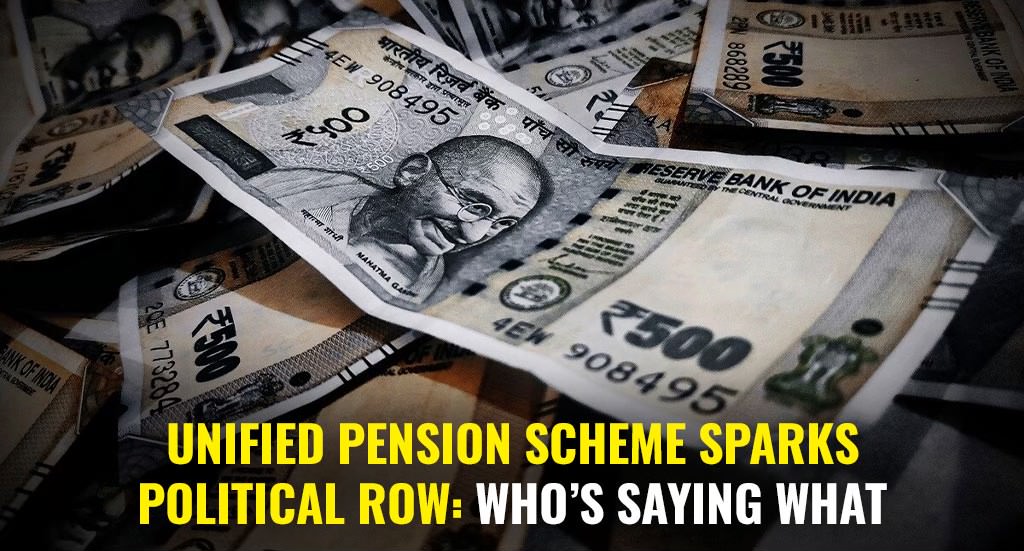The Union government has approved the Unified Pension Scheme (UPS) for government employees. The new scheme, which replaces the National Pension Scheme (NPS), will offer guaranteed pension benefits for those government employees who joined service after January 1, 2004. The move is being viewed by political experts as strategically timed before upcoming state assembly elections in Maharashtra, Jharkhand, Haryana, and Jammu and Kashmir. Elections in Haryana are set for October 1. The state is home to a large number of government employees and pension-related announcements could influence the voting outcome. The UPS offers 50% of an employee’s average salary from the last 12 months as a pension, inflation adjustments and other benefits.
‘U’ for Modi Govt’s U-turns, Alleges Congress President
Congress President Mallikarjun Kharge spearheaded the party’s charge against the BJP government, stating that the ‘U’ in the UPS stands for the BJP-led Modi government’s U-turns. Kharge cited the recent rollback in the budget regarding indexation, sending the Waqf Bill to the Joint Parliamentary Committee (JPC), the revoking of the Broadcast Bill and the revoking of ‘Lateral Entry’ hiring in bureaucracy by the NDA government.
On Sunday, at a press conference at the BJP headquarters in New Delhi, senior leader Ravi Shankar Prasad praised Prime Minister Narendra Modi for introducing a unified pension scheme (UPS) for central government employees, highlighting his commitment to addressing their issues through the Somanathan Committee. The BJP spokesperson criticised the Congress for making false promises about the Old Pension Scheme (OPS) and failing to fulfill them. He questioned the Congress’s sincerity, pointing out their lack of commitment to OPS in their recent election campaigns and accused Rahul Gandhi of misleading the public.
Prasad criticised Congress president Mallikarjun Kharge for criticising the Centre’s decision, asserting that PM Modi’s decisions are made in the public interest and after careful consideration, not on an ad-hoc basis. He challenged Kharge to explain why the Congress party reversed its promise to implement the old pension scheme in Himachal Pradesh, Karnataka, and Telangana after winning elections in these states, despite previously making it a major political issue.
Pawan Khera, head of the Congress’ media and publicity department, weighed in criticising the United Pension Scheme (UPS) and calling it an attack on Dalits, tribals, and backward classes. He pointed out that in many states, the upper age limit for government jobs for reserved categories is 40 years, and in the UPSC, it’s 37 years. Since the UPS requires 25 years of service for a full pension, Khera questioned how employees from these communities would benefit. He urged the government to clarify whether it intends to remove the upper age limit or deny these groups full pension benefits.
हमारे प्रधानमंत्री जी मांगों को सुनते हैं, समझते हैं और संवेदनशील रहते हैं। जब कर्मचारियों के अखिल भारतीय संगठन ने मांग की, तो पिछले साल ही तत्कालीन वित्त सचिव सोमनाथन जी की अध्यक्षता में एक कमेटी बनी थी। उस कमेटी की रिपोर्ट को कल कैबिनेट में स्वीकार किया गया है।
— BJP (@BJP4India) August 25, 2024
जिसके तहत भारत… pic.twitter.com/urKOilF3QQ
UPS Excludes Paramilitary Forces: AAP
The Aam Aadmi Party (AAP), a partner in the Congress-led INDIA bloc, criticised the United Pension Scheme (UPS), calling it a “massive fraud” on employees. AAP argued that the scheme is worse than the New Pension Scheme, as it excludes paramilitary forces whose service duration is typically less than 25 years, disqualifying them from receiving the full benefits under the UPS. AAP highlighted that excluding paramilitary forces from the scheme is a significant flaw.
Maharashtra became the first state to allow its employees to switch to the UPS, with expectations that other states, particularly those under NDA rule, may follow suit. This decision was made shortly after the Union Cabinet approved the UPS.
What’s UPS?
The new United Pension Scheme (UPS) guarantees a minimum pension of ₹10,000 per month after at least 10 years of service. This scheme will initially benefit 23 lakh central government employees, potentially expanding to 90 lakhs if state governments opt-in. Union Minister Ashwini Vaishnaw also announced features such as an assured family pension for spouses of deceased employees and inflation indexation on pensions. The UPS represents a transformation of the National Pension System (NPS), which was based on contributions from both employees and the government. The announcement comes as some non-BJP states are reverting to the DA-linked Old Pension Scheme (OPS).
How is OPS different from UPS?
The key distinction between the Old Pension Scheme (OPS) and the new Unified Pension Scheme (UPS), effective from April 1, 2025, is that OPS was unfunded, while both UPS and the current New Pension Scheme (NPS) are fully funded. Funded schemes rely on returns from investments, compulsory contributions from employees and employers, and annual budget allocations to meet financial obligations. The UPS will offer a guaranteed monthly pension of 50% of the average base pay from the past 12 months to employees with 25 years of service, addressing a major demand from staff unions. Most central government employees are expected to transition from NPS to UPS due to these benefits.
The Old Pension Scheme (OPS), discontinued in 2004, provided a fixed monthly pension of 50% of the base salary for employees with at least 20 years of service, without requiring employee contributions. This led to unsustainable pension liabilities. The New Pension Scheme (NPS), introduced in 2004 as a fiscal reform, required a 14% government contribution and a 10% employee contribution to address mounting debts. The new Unified Pension Scheme (UPS), effective from April 1, 2025, will offer a similar pension structure to OPS but with improved funding: the government will contribute 18.5%, and employees will continue to contribute 10%, ensuring a guaranteed pension amount.








